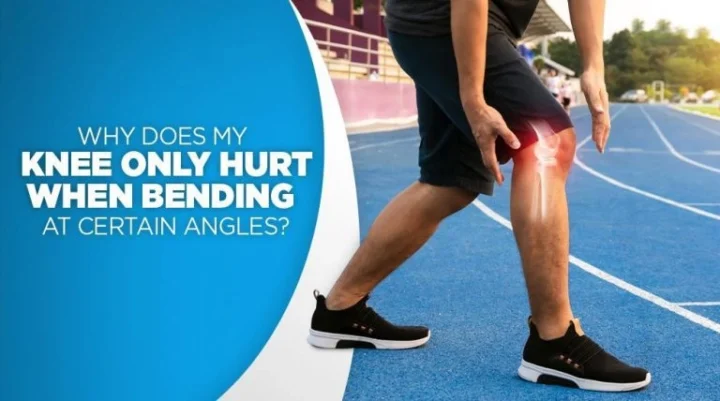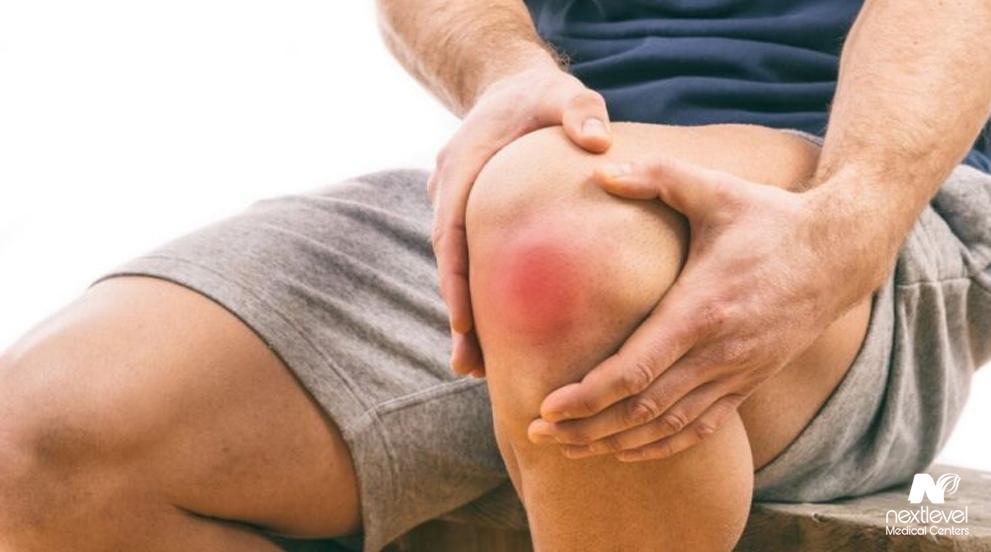

The human body is akin to a machine with parts designed for specific purposes. Unlike machines, we cannot simply replace a part when it starts to wear down from extended use, and we have to take care to let them recover. However, sometimes parts of our body tend to ache or produce pain from the simplest use for no readily apparent reasons. One of the most common sites for this sudden pain is the knees, which see a great deal of use compared to other parts of our bodies.
Sometimes, the pain we experience in our knees only occurs when we move or orient them in a specific way. In other cases, the pain can be all-encompassing and affect our knees no matter how we bend them. This variation can be confusing if you are unaware of what is causing the pain and, therefore, unsure how to fix it. With this article, we hope to provide some guidance on what can cause knee pain at certain angles or in general.
While this is an obvious cause, it warrants explanation solely because people out there might unintentionally damage their knees through everyday activities or being built a specific way. As we previously discussed, the human body is evolved explicitly so that each bone, organ, and limb can accomplish specific roles for the human experience. As a result, trying to defy those designs can lead to pain.
Now, we are not saying you are going around trying to bend your knee upward, but sometimes we move in ways that force our limbs into positions they are not meant to be. Unfortunately, this positioning leads to a painful condition known as hyperextension. Knee pain is one of the main symptoms of hyperextension, and it is a reasonably common issue that could very well be the source of your pain.

Knee hyperextension is caused when your knee joint bends backward and, as a result, damages the tissue around your patella (or kneecap). Hyperextension can be caused by simply falling or landing from a high jump or any other direct blow to the knee. However, even those who are not physically active can experience hyperextension and suffer from pain in the knee.
The pain can occur when bending the knee in a specific way due to the way the damage occurred. Depending on where the damage is, bending your knee in certain ways can minimize the amount of pain you feel, whereas other ways can result in exacerbated pain.
Patellofemoral pain syndrome, more colloquially known as runner’s knee, is one of the most common issues that affect the human knee. In addition to being a common issue, it is the most common source of pain around the knee. Runner’s knee involves the kneecap moving in ways that cause it to grind against the cartilage surrounding the knee and leads to friction. This friction damages the bone around the knee and causes symptoms.
Generally, the pain from the runner’s knee is isolated to the front of the kneecap (patella), where the friction is strongest. However, the pain can also occur behind or around the patella and spikes when bending your knee. Depending on where the pain is focused, certain activities and angles might hurt worse than others.

Runner’s knee can be caused by trauma like hyperextension but can also stem from overuse, misalignment of the bones, or underlying conditions that degrade the cartilage around the bone. Regardless of the cause, the location of the damage once again regulates which angles will be the most painful and which will be more on the bearable side of things.
Knee bursitis is a less common issue in the knee but is no less worthy of note. Within the knee joint, small sacs called bursa are filled with fluid. Bursae are essential to the knee’s health because they protect your knee joint’s pressure points and reduce the level of friction they experience. However, bursae can be inflamed and bring knee bursitis as a result.
Knee bursitis can be extremely painful as the inflamed bursae experience pressure from everyday movements. However, the causes of knee bursitis are a little too common for comfort. Frequent pressure on the knee from prolonged kneeling, sports, and even obesity can lead to the onset of knee bursitis. It can also be brought on from a bacterial infection.

Knee bursitis can occur in multiple variants that affect different bursae in the knee. These variants include:
Like all of the conditions we have discussed, knee bursitis can cause pain when bending your knee. However, depending on which of your bursae are inflamed, the pain might only occur at specific angles and might be avoided by controlling the angles.
A Bakers cyst relates once more to the bursae found in the knee joint. However, a Bakers cyst occurs specifically on the semimembranosus bursa located at the back of the knee. Bakers cysts are extremely unpleasant not only because they are painful but also because they produce a bulge in the back of the knee that can experience pressure when sitting.

While a Bakers cyst causes pain when straightening or bending your knee, extreme cases can even make it impossible to bend your knee at all. In these cases, you will not have to worry about the angle at which you bend your knee, but you might experience a greater degree of discomfort and pain overall.
It is worth noting that a Bakers cyst is also a form of bursitis known as semimembranosus bursitis. However, given the unique position of the semimembranosus bursa and the effect of fluid buildup, we felt that this particular form of bursitis warranted a little extra attention.
A Bakers cyst can be caused when the fluid your body produces to keep your knees operating smoothly is produced in excess. As the pressure builds up from the fluid, it is forced into the bursa, which causes the cyst to grow. That said, a Bakers cyst can also be caused due to arthritic conditions.
As you might have gathered thus far, cartilage plays an essential role in the health of the knee. However, a critical type of cartilage called the meniscus lines the joint and exists as a cushion to protect it from damage. It also redistributes the energy through your knee. Unfortunately, despite the importance of the meniscus, it is prone to tearing in some circumstances, and this is not something that can be sewn back up.
Meniscus tears involve weakening the cartilage until it frays, reducing the protection it ordinarily affords your knee joint. When the meniscus tears, it can severely limit the level of mobility you can accomplish with your knee, including bending. Meniscus tears cause extreme pain when attempting to bend your knee in a way that exacerbates the tear. The location of the tear can correlate to the angles that cause the most pain.

Meniscus tears are, unfortunately, caused by simple wear and tear. However, attempting to twist your knee to adjust your position without moving your foot along with it can also be a significant cause of tearing.
Arthritis is one of the most common inflammatory conditions globally, afflicting a wide array of the population. With over 200 variations of the disease, it is no wonder it has managed to spread across the globe. Osteoarthritis is specifically known to cause knee pain when attempting to angle or maneuver it. Osteoarthritis involves the thinning of cartilage and bone scraping against bone, resulting in friction. This friction, as you might expect, is extremely painful.

Osteoarthritis, and all of its variants, can have many potential causes ranging from simple overexertion of the joint to a genetic predisposition. Regardless of the cause, pain is the most prominent symptom and can be exacerbated when bending your knees.
Depending on where the friction is most concentrated, the pain can spike in specific knee areas and result in the symptoms worsening when you bend along those areas. Fortunately, osteoarthritis tends to manifest after 65, but it can manifest earlier in life, especially if you fall under the demographic of those with a genetic predisposition.
Iliotibial band syndrome is a highly debilitating condition that afflicts the lateral knee, which houses the iliotibial tract. The iliotibial tract is just a medical term for a strand of connective tissue that runs from your hip to the outer side of your leg to your knee and patella. The IT band is responsible for the rotation of the hip. When the band becomes inflamed or damaged, friction occurs on the outside of the knee when you attempt to bend it.

The friction from IT band syndrome causes extreme pain when bending your knee and is simply an overuse injury. This means it is common in athletes and gym enthusiasts alike, especially cyclists and runners. However, if you frequently go up and down stairs, spend a lot of time sitting with bent knees, or walk in high heels, you are also at risk of developing the condition.
Additional risk factors include:
There are more, but we have covered the most common causes. The severity of IT band syndrome can affect which angles cause the knee pain; however, it is known to encompass a set area. So, you should expect the pain to be fairly comprehensive around the knee in general.
Knee pain is an all-too-common occurrence with not enough avenues for relief. Sometimes the conditions can be mitigated by simply avoiding certain positions when bending your knees, and other times it is entirely unavoidable. However, if you have pain in your knee, you either have endured a superficial traumatic injury, or you have a condition like one of those listed above. Regardless of the cause, it is safe to assume that you would like relief if at all possible.

If you are looking for ways to alleviate the pain in your knee, you might want to consider contacting us at Ortho Integrative. We have a well-tailored KneeSpa program drafted from minds like that of Dr. Emmett Blahnik designed to offer several treatments to mitigate pain from knee damage. We even offer services to tend to knee pain that has become a chronic issue with specialties in conditions like bursitis and osteoarthritis. If you are tired of feeling pain whenever you bend your knees to perform simple tasks, give us a call. It might be time to take your health to the Next Level.
Additionally, if you simply have any questions regarding sources of knee pain, management of knee pain, or what we can do for you at Ortho Integrative, please feel free to reach out and contact us at any time! We understand that managing knee pain can be a serious matter for those who live with it, and we would love to help you with resolving it however we possibly can.